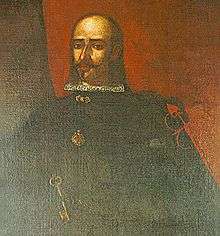Baltasar de la Cueva, Count of Castellar

Don Baltasar de la Cueva y Enríquez de Cabrera, iure uxoris Count of Castellar and Marquis of Malagón (sometimes Baltasar de la Cueva Enríquez de Cabrera y Arias de Saavedra) (1626 in Madrid – April 2, 1686[1]) was viceroy of Peru from August 15, 1674 to July 7, 1678.
He was a younger son of the Duke of Alburquerque, and brother of Francisco Fernández de la Cueva, 8th Duke of Alburquerque, who served as Viceroy of New Spain.[2] He married Teresa María Arias de Saavedra, 7th Countess of Castellar.
His administration
He was welcomed upon his arrival in Peru at the port of Callao on August 11, 1674 with the celebration of a corrida. There were also bullfights in Lima on November 6, 1674.[3]
On November 15, 1674 he reported to the Spanish Court that it was necessary to reduce the number of holidays in the viceroyalty, because the number then "exceeded 35, that, together with religious holidays, almost means that the greater part of the year is a holiday". On May 14, 1676 the Court issued a decree approving a reduction.
During his period of administration, the laws of the Indies were compiled.[4] Viceroy Cueva took steps to protect the Pacific coast from English and Dutch pirates. In 1675 he sent Antonio de Vea to investigate reports that the English had established bases in Patagonia.
Ilyas ibn Hanna al-Mawsili
Ilyas ibn Hanna al-Mawsili (Elias, son of John of Mosul), a Chaldean Christian of Assyrian descent, departed from Cádiz, Spain for Peru on February 13, 1675. He was almost certainly the first Assyrian to visit the New World. His mission was to raise money for the repair of a Assyrian church in Baghdad and to gather alms for the Chaldean community. Ilyas traveled to many places in the viceroyalty, and met the viceroy in Lima. The two became friends.[5]
Uprising of Pedro Bohórquez (Inca Hualpa)
During this time a curious fraud occurred, resulting in an Indian uprising. Rumors of enormous wealth hidden generations earlier by the Indigenous in caves and lakes circulated widely. A campesino born in Quito (some sources say he was born in Spain) named Pedro Bohórquez took advantage of these rumors. He announced that he was Inca Hualpa, a descendant of Atahualpa, and a prince of the Andes. He spoke perfect Quichúa and had been accepted as a prince by the Andean tribes of Tucumán (Argentina). He claimed that his subjects knew the locations of the hidden treasures, and with that claim he was able to take in the governor of Río de la Plata, Alonso Mercado y Villacorta, marqués de Villacorta.
Inca Hualpa told the governor that for him to be able to get the information from the few subjects who knew it, the governor would need to recognize him as Prince of the Land. Only that would give him the authority to take possession of the hidden treasures. The governor did allow the Indigenous to proclaim him prince, and he even left with an entourage to greet and congratulate Inca Huallpa. The latter set out to meet the governor. They met in Tafí and exchanged compliments.
When Viceroy Cueva heard of the fraud, he ordered that Bohórquez (Inca Hualpa) be arrested. Bohórquez returned to his followers in the Andes, where he denounced the "treason" of the Spanish and incited the Indigenous to revolt. The Calchaquíes took up arms, but they were disastrously defeated. The survivors were distributed to encomiendas. Other associated tribes were removed from their mountain valleys and transported to distant places. The Quilmes were transported to Buenos Aires, where a town still bears that name. Bohórquez himself was taken to Lima and hanged.
Other reports claim that Bohorques had earlier duped Viceroy Cueva, making him think that he had discovered the "fabulous country of Enin, and visited its gold palaces and precious treasures." The viceroy was deceived, and gave him 36 soldiers. Bohórquez then disappeared.
Removal from office
A conflict with the powerful merchants of the colony led to Cueva Enríquez's removal from office.[6] On July 7, 1678 Archbishop Melchor Liñán y Cisneros replaced him as viceroy. He died in 1686.
Notes
- ↑ Genealogy of Baltasar de la Cueva and Teresa María de Saavedra
- ↑ (Spanish) "Baltasar de la Cueva Enríquez" at Biografías y Vidas
- ↑ (Spanish) "Historia de las Ferias Taurinas en Perú"
- ↑ (Spanish) Pueblos Indíginas de Bolivia
- ↑ Paul Lunde, "The New World Through Arab Eyes", Saudi Aramco World, May/June 1992
- ↑ (Spanish) "Biografía de Baltasar de la Cueva Enríquez"
For the conflict with the merchants cf. Margarita Suárez, Desafíos transatlánticos, p. 374 y ss.
References
| Government offices | ||
|---|---|---|
| Preceded by Bernardo de Iturriaza |
Viceroy of Peru 1674 – 1678 |
Succeeded by Melchor Liñán y Cisneros |